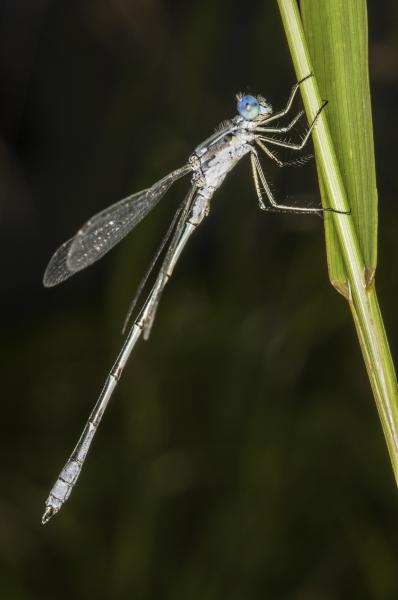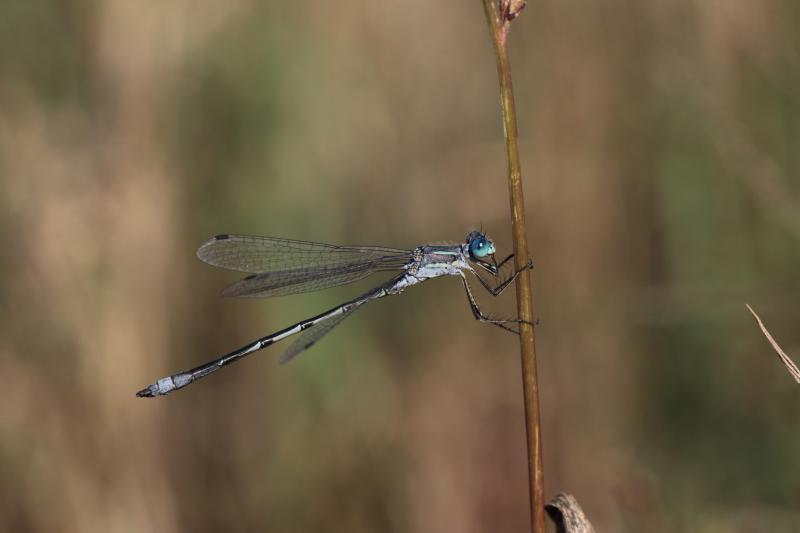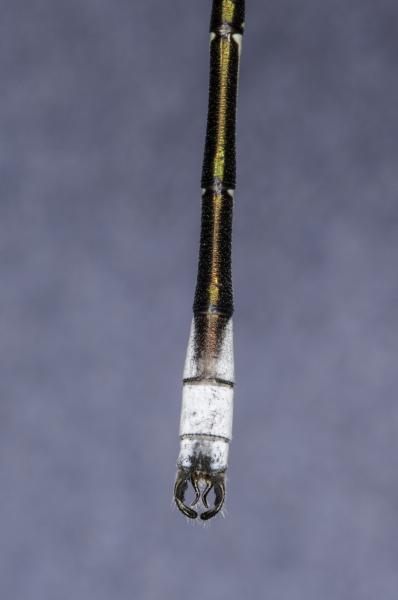Lyre-tipped Spreadwing
Lestes unguiculatus Hagen, 1861
- Class
- Insecta (Insects)
- Family
- Lestidae (Spreadwings)
- State Protection
- Not Listed
Not listed or protected by New York State.
- Federal Protection
- Not Listed
- State Conservation Status Rank
- S2S3
Imperiled or Vulnerable in New York - Very vulnerable, or vulnerable, to disappearing from New York, due to rarity or other factors; typically 6 to 80 populations or locations in New York, few individuals, restricted range, few remaining acres (or miles of stream), and/or recent and widespread declines. More information is needed to assign either S2 or S3.
- Global Conservation Status Rank
- G5
Secure globally - Common in the world; widespread and abundant (but may be rare in some parts of its range).
Summary
Did you know?
The Lyre-tipped Spreadwing is so named because the paraprocts (terminal appendages) on the tip of the abdomen on males are divergent and form a lyre (the stringed instrument) shape.
State Ranking Justification
In New York, Lestes unguiculatus was known from 26 counties (Donnelly 1999) across New York prior to the beginning of the New York Dragonfly and Damselfly Survey (NYDDS, 2005-2009). It was documented in 9 locations within four counties in this region of the state during the NYDDS (White et al. 2010). The species appears to be sporadic or episodic in its occurrence in the state and presence can vary greatly from year to year across sites. But with this consideration, the species records over a five year period (2005-2009) compared with previous records appears to be declining.
Short-term Trends
In New York, Lestes unguiculatus was known from 26 counties statewide (Donnelly 2004) including northern, western, central, southern New York, and Long Island prior to the beginning of the New York Dragonfly and Damselfly Survey (NYDDS, 2005-2009). It was documented in 9 locations within four counties in the state during the NYDDS (White et al. 2010). Despite the increased survey effort during the NYDDS, county observations decreased which could be reflective of a population decline. The species appears to be sporadic or episodic in its occurrence in the state and presence can vary greatly from year to year across sites (Donnelly pers comm).
Long-term Trends
Long-term information regarding population size is not available prior to the late 1990s (New York Natural Heritage Program 2017). Since observations are fairly recent, and the full extent and size of the populations have not been determined, long-term trends are unclear.
Conservation and Management
Threats
Any activity which might lead to water contamination or the alteration of natural hydrology could affect Lyre-tipped Spreadwing populations (NYS DEC 2005). Such threats may include roadway and agricultural run-off, industrial pollution, the building of dams, recreational boating, and development near their habitats (NYS DEC 2005). Groundwater withdrawal is a potential threat in lentic habitats, as are invasive plant species replacing native plants required for oviposition (New York Natural Heritage Program 2017). Both emergence rates and/or species ranges may shift for damselflies as a result of climate change in New York (Corser et al. 2015).
Conservation Strategies and Management Practices
Any efforts to reduce roadway and agricultural run-off, eutrophication, development of upland borders and resulting increased groundwater withdrawal, and ditching and filling activities should be considered when managing for this species (NYS DEC 2005).
Research Needs
Further research is needed to define the distribution and population size of the Lyre-tipped Spreadwing. In addition, research is required to understand the habitat requirements and threats to this species, and to create appropriate management guidelines for its persistence in known locations (NYS DEC 2005). Monitoring for this species over time is needed to determine if they are truly in decline.
Habitat
Habitat
Lyre-tipped Spreadwings are known to inhabit small ponds and marshy wetlands, often in open, temporary situations that dry up in mid-summer (Lam 2004, Paulson 2011).
Associated Ecological Communities
- Eutrophic pond*
(guide)
The aquatic community of a small, shallow, nutrient-rich pond. The water is usually green with algae, and the bottom is mucky. Eutrophic ponds are too shallow to remain stratified throughout the summer; they are winter-stratified, monomictic ponds.
- Pine barrens vernal pond
(guide)
A seasonally fluctuating pond and its associated wetlands that typically occurs in pine barrens. The water is intermittent, usually a pond in the spring but sometimes losing water through the summer to become a mostly vegetated wetland at the end of the summer. These ponds and wetlands may be small.
- Shallow emergent marsh*
(guide)
A marsh meadow community that occurs on soils that are permanently saturated and seasonally flooded. This marsh is better drained than a deep emergent marsh; water depths may range from 6 in to 3.3 ft (15 cm to 1 m) during flood stages, but the water level usually drops by mid to late summer and the soil is exposed during an average year.
- Vernal pool
(guide)
An aquatic community of one or more intermittently ponded, small, shallow depressions typically within an upland forest. Vernal pools are typically flooded in spring or after a heavy rainfall, but are usually dry during summer. Substrate is typically dense leaf litter over hydric soils. Vernal pools typically occupy a confined basin (i.e., a standing waterbody without a flowing outlet), but may have an intermittent stream flowing out of it during high water. This community includes a diverse group of invertebrates and amphibians that depend upon temporary pools as breeding habitat. These include amphibians, reptiles, crustaceans, mollusks, annelids, and insects.
* probable association but not confirmed.
Associated Species
- Canada Darner (Aeshna canadensis)
- Shadow Darner (Aeshna umbrosa)
- Marsh Bluet (Enallagma ebrium)
- Common Spreadwing (Lestes disjunctus)
- Emerald Spreadwing (Lestes dryas)
- Amber-winged Spreadwing (Lestes eurinus)
- Sweetflag Spreadwing (Lestes forcipatus)
- Slender Spreadwing (Lestes rectangularis)
- Frosted Whiteface (Leucorrhinia frigida)
- Sedge Sprite (Nehalennia irene)
- Ski-tailed Emerald (Somatochlora elongata)
- White-faced Meadowhawk (Sympetrum obtrusum)
- Band-winged Meadowhawk (Sympetrum semicinctum)
Range
New York State Distribution
Lyre-tipped Spreadwings have been documented in 30 counties including northern, western, central and southern New York, plus Long Island. During a recent odonate atlas (White et al. 2010), their distribution was determined to include the four counties of Saratoga, Chenango, St. Lawrence, and Jefferson. The species appears to be sporadic or episodic in its occurrence in the state and presence can vary greatly from year to year across sites.
Global Distribution
The global range for Lyre-tipped Spreadwings extends from British Columbia eastward through Canada to Nova Scotia and Newfoundland and southward into the United States covering most states except for the most southern below the line of California and Tennessee (Abbott 2006-2017). New York lies near the eastern edge of the overall range.
Best Places to See
- Wilton Wildlife Preserve and Park (Saratoga County)
Identification Comments
Identifying Characteristics
Lyre-tipped spreadwing males have a dark metallic thorax with pale (blue-green or tan) shoulder stripes; sides become pruinose pale blue to white with age. The abdomen is metallic dark green to brown above. The abdominal tip often becomes pale gray with age (segments 9 and 10), pruinosity leaving a dark triangle on the top of segment 8. Males may be separated from other similar Lestes by the shape of their terminal appendages, of which the paraprocts are divergent and lyre-shaped. Females have a green thorax above with pale (tan, blue-green, or yellow) sides and pale shoulder stripes. Their abdomens are metallic brown or green above and pale below and the rear of their heads are pale (Nikula et al. 2003, Lam 2004, Paulson 2011).
Diet
Lyre-tipped larvae feed on smaller aquatic invertebrates and adults feed on insects which they capture in flight.
Best Time to See
Lyre-tipped spreadwing adults have been found in New York from June through September. Larvae may be found in appropriate habitats year-round.
- Present
- Reproducing
The time of year you would expect to find Lyre-tipped Spreadwing present and reproducing in New York.
Similar Species
- Common Spreadwing (Lestes disjunctus)
Northern and Southern (Lestes australis) Spreadwings are very similar, but males typically have a darker thorax and abdomen and their pruinosity does not form a dark triangle on abdominal segment 8. Females are more slender than Lyre-tipped spreadwings and the rear of their heads are dark (Lam 2004).
- Sweetflag Spreadwing (Lestes forcipatus)
Sweetflag Spreadwings are very similar, but males typically have a darker thorax and abdomen and their pruinosity does not form a dark triangle on abdominal segment 8 (Lam 2004).
Lyre-tipped Spreadwing Images
Taxonomy
Lyre-tipped Spreadwing
Lestes unguiculatus Hagen, 1861
- Kingdom Animalia
- Phylum Arthropoda
(Mandibulates)
- Class Insecta
(Insects)
- Order Odonata
(Dragonflies and Damselflies)
- Family Lestidae (Spreadwings)
- Order Odonata
(Dragonflies and Damselflies)
- Class Insecta
(Insects)
- Phylum Arthropoda
(Mandibulates)
Additional Resources
References
Abbott, J.C. 2006-2017. OdonataCentral: An online resource for the distribution and identification of Odonata. Available at http://www.odonatacentral.org. (Accessed: March 17, 2017).
Corser, Jeffrey D, Erin L. White and Matthew D. Schlesinger. 2015. Adult activity and temperature preference drives region-wide damselfly (Zygoptera) distributions under a warming climate. Biology Letters 11(4): 20150001.
Donnelly, T. W. 1992. The odonata of New York State. Bulletin of American Odonatology. 1(1):1-27.
Donnelly, T.W. 1999. The Dragonflies and Damselflies of New York. Prepared for the 1999 International Congress of Odonatology and 1st Symposium of the Worldwide Dragonfly Association. July 11-16, 1999. Colgate University, Hamilton, New York: 39 pp.
Donnelly, T.W. 2004c. Distribution of North American Odonata. Part III: Calopterygidae, Lestidae, Coenagrionidae, Protoneuridae, Platystictidae, with data sources and bibliography, parts I-III. Bulletin of American Odonatology 8(2-3):33-99.
Lam, E. 2004. Damselflies of the northeast: A guide to the species of eastern Canada and the northeastern United States. Biodiversity Books, Forest Hills, New York. 96 pp.
New York Natural Heritage Program. 2017. Element Occurrence Database.State University of New York College of Environmental Science andForestry, Albany, NY.
New York Natural Heritage Program. 2024. New York Natural Heritage Program Databases. Albany, NY.
New York State Department of Environmental Conservation. 2005. Comprehensive Wildlife Conservation Strategy Planning Database. New York State Department of Environmental Conservation. Albany, NY.
Nikula, B., J.L. Loose, and M.R. Burne. 2003. A field guide to the dragonflies and damselflies of Massachusetts. Division of Fisheries and Wildlife, Natural Heritage and Endangered Species Program, Westborough, MA. 197 pp.
Paulson, D. 2011. Dragonflies and damselflies of the east. Princeton University Press, Princeton, New Jersey, USA.
Soltesz, Ken. 1992. Proposed Heritage ranks for New York State odonata. Unpublished report for New York Natural Heritage Program. 37 pp.
White, Erin L., Jeffrey D. Corser, and Matthew D. Schlesinger. 2010. The New York Dragonfly and Damselfly Survey 2005-2009: distribution and status of the odonates of New York. New York Natural Heritage Program, New York State Department of Environmental Conservation. Albany, NY. 450 pp.
Links
About This Guide
This guide was authored by: Erin L. White
Information for this guide was last updated on: March 31, 2017
Please cite this page as:
New York Natural Heritage Program. 2024.
Online Conservation Guide for
Lestes unguiculatus.
Available from: https://guides.nynhp.org/lyre-tipped-spreadwing/.
Accessed July 26, 2024.


